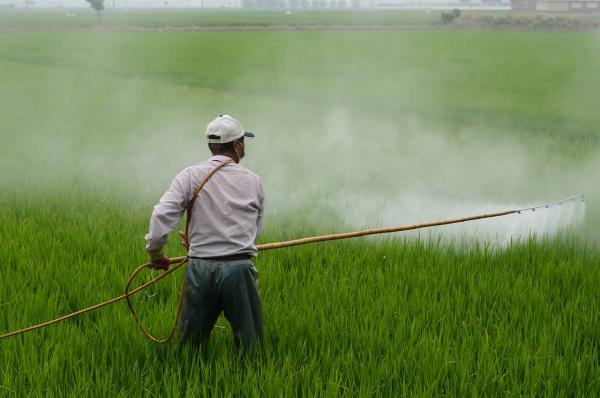Some websites declare everyone has used or been exposed to glyphosate at some point, providing a treasure trove of potential plaintiffs. One plaintiff’s lawyer claimed,
“It is ubiquitous….[Indeed] it is difficult to conduct a study comparing those who had been exposed and those who had not because it was difficult to find people who had not been exposed, because ‘[i]t’s pervasive.’”
For such a pervasive chemical, [1] Roundup’s supposed carcinogenic impact appears relatively low, with an incidence paling in comparison to breast, lung, and prostate cancers, and lower than four other cancers. Non-Hodgkins Lymphoma (NHL), a cancer of the lymph system, and the most common claim against Bayer, accounts for 4% of all cancers in America. However, its incidence has declined by about 1% per year since 2015, even as Roundup use escalated for the decade prior.
The first Roundup lawsuit went to trial in 2018, and the first three verdicts went to plaintiffs (relying on the IARC 2015 indicating glyphosate as a probable carcinogen). Then came the settlements. Over 100,000 lawsuits have been settled (for $11 billion); another 40,000 cases are pending. Then the EPA and others sounded in, assuaging Roundup cancer fears, and the defendants won the subsequent eight cases. Inexplicably, the tide again turned with the following five cases going to the plaintiffs.
So, can Bayer seize back their lead – or are we in danger of a Roundup recall? And why can’t we keep the bad science out of the courtroom?
The short answer is don’t look to the Roundup cases for simple solutions regarding scientific evidence. There’s too much going on besides the science. The longer answer requires a deep dive into legal admissibility standards.
What is Legally Admissible Scientific Evidence? - Daubert versus Frye Standards
- The Daubert admissibility standard (the law in all federal and 43 state courts) requires both reliable data and relevant testimony. And, as augmented by the Joiner case, there must be a logical nexus between the data and a reliable expert’s opinion, with the judge charged as a “gatekeeper” to exclude “junk science.”
- Frye (the law in the remaining seven states, with some having additional provisions) allows scientific admissibility based on the consensus of a general scientific community. The judge is not charged with a “gatekeeper” function to exclude junk science.
The Tylenol, Lexapro, and Zantac federal suits assessed the scientific evidence needed to prove general causation, i.e that a chemical can cause cancer in the general population, in a Daubert hearing. After the hearings, the judges dismissed the cases, having not found reliable proof of general causation.
By comparison, with one exception, Roundup’s initial cases were heard in three state courts: Missouri, California, and Pennsylvania, utilizing the Frye standard to determine the admissibility of scientific evidence. As Susan Goldhaber writes, the suspect 2015 IARC finding that glyphosate is a ‘probable human carcinogen’ provided the predicate to admit questionable studies and gave the jury a basis for finding liability.
Missouri’s evidentiary standards are in flux: “as a practical matter, the statute re-enshrines the Frye test as a threshold matter and admits expert testimony — even “junk science….” Newer Missouri rules require some adherence to Daubert, although the data upon which an expert relies isn’t subject to the Daubert reliability-inquiry. This sinkhole provides a wider admissibility window for weaker data. Perhaps not surprisingly, the blockbuster verdicts emanated from these jurisdictions, including a bell-ringing $1.56 billion verdict. However, Missouri cases also returned five verdicts in favor of Bayer.
Punitive Damages: The Anger Award
The huge verdicts generally reflect punitive damages more than pain and suffering awards. In the S1.56 billion award, three plaintiffs suing for NHL received $61 million in compensatory damages but half a billion dollars each in punitive damages.
“Punitive damages are available where the plaintiff proves ‘by clear and convincing evidence that the defendant has been guilty of oppression, fraud or malice. ‘Malice’ includes ‘despicable conduct which is carried on by the defendant with a willful and conscious disregard of the rights or safety of others…. The most important of the three guideposts is the reprehensibility of the defendant’s conduct.’”
I call “punitives” the “anger award” because they need not relate to the claim, but to defendant's actions that the jury finds offensive. Usually, these relate to evidence of greed, fraudulent tactics, or a finding that the defendant concealed dangers to maximize profits. In the Roundup cases, one Court noted that allegations were raised that Monsanto impeded scientific inquiry:
“The size of the punitive damages award was based on evidence presented at trial that Monsanto was more concerned with tamping down safety inquiries and controlling public opinion around Roundup than it was with ensuring that its product is safe. California law provides for punitive damages where a defendant acts “with a willful and conscious disregard of the rights or safety of others.”
Without a causal relation between the product and the harm, even a manufacturer's egregious tactics will not generate damages – punitive or otherwise. And even with such connection, constitutional caps limit the amount of punitive damages, especially as here, where the alleged “malice” of Monsanto must be viewed in context, As described by one judge who opposed the size of these awards:
“There was no evidence that Monsanto believed, let alone knew, that Roundup or glyphosate was carcinogenic. No evidence that Monsanto used “trickery” or “deceit” in working with scientists to author literature or to respond to an IARC determination with which Monsanto (and many regulators and scientists worldwide) disagreed. And no evidence that Monsanto hid any scientific study from regulators or the scientific community.”
Nevertheless, the plaintiffs in these cases still prevailed. How?
Experts and Strategy: A Hot Approach Needed for Cold Data
From a legal standpoint, the scientific evidence regarding glyphosate was initially equivocal. The federal court handling an early 2019 MDL relied on complex and confusing epidemiology and the 2015 IARC conclusion to prove general causation. A video of part of that Daubert expert hearing can be seen here. But, as time went on, more scientific papers and government bodies, including the EPA, disavowed the causal connection between glyphosate and cancer:
“In February 2020, after … considering public comments …EPA found that there are no risks of concern to human health when glyphosate is used in accordance with its current label. EPA also found that glyphosate is unlikely to be a human carcinogen.”
- EPA
Following this EPA directive, Bayer won all cases between 2021 and early 2023, primarily by presenting an alternative and convincing explanation for the plaintiffs’ non-Hodgkins lymphoma.
Bayer’s expert, Dr. Christian Thomasetti, an associate professor of Biostatistics at Johns Hopkins, testified [2] that random mutations in human stem cells cause 96% of NHL cases and that most cancers are genetically mediated; “ with “luck “ (in this instance bad) intrinsic in a person’s cancer-fate. So effective was Dr. Thomasetti that the plaintiffs’ lawyers pointedly orchestrated an anti-Thomasetti offensive:
“He’s savvy….It took us a few trials to figure him out, because when you say 97% in front of a jury, that’s a powerful number.”
- Scott Love, plaintiff’s lawyer
The plaintiffs kept hammering that Dr. Thomasetti is not a medical oncologist but a cancer biostatistician whose opinions are based on statistical evidence, along with other parts of the Monsanto narrative.
“We knew [this message that there was no evidence that Roundup caused non-Hodgkin lymphoma] … had been successful, …, and we went about the business of how to successfully challenge that misguided principle, which they had successfully gotten by all these juries.”
- Tom Kline, plaintiff’s lawyer
Commenting on the five-verdict winning streak, plaintiff-lawyer Kline explained that plaintiffs’ lawyers now script their cases differently and share their institutional knowledge, transcripts, and thinking with their compadres:
“We established a template for trying the case differently, and that, in turn, I think, is a harbinger of 2024 and beyond.”
Wrong. In December, Bayer notched another win.
On December 23, Bayer won its tenth verdict, ending the plaintiffs’ 5-case winning streak totaling billions of dollars. It seems the wins resulted from good trial strategy, communications theater, sympathetic plaintiffs, and confusing science. But, as ACSH’s Susan Goldhaber has written the wins favoring Bayer suggest that juries can and do learn the science, even if the judges can’t.
So, with one case currently proceeding and 40,000 cases pending, is past prologue? What can we expect in the future? Stay tuned.
[1] Exposure to glyphosate in the United States: Data from the 2013–2014 National Health and Nutrition Examination Survey - 80% of Americans may have traces of glyphosate in their urine.
[2] You can find his thinking here on a YouTube video.




